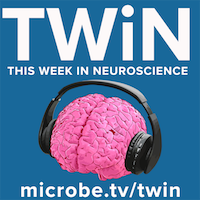TWiN explains a study showing that when a mouse is confronted with an unconscious conspecific, it engages in behavior including tongue-dragging to resuscitate the animal via a tongue-brain connection. Hosts: Vincent Racaniello, Tim Cheung, and…
TWiN discusses a study showing that repetitive injury reactivates HSV-1 in a human brain tissue model and induces phenotypes associated with Alzheimer’s disease. Hosts: Vincent Racaniello and Tim Cheung Click arrow to playDownload TWiN 057 (29…
TWiN explains a study showing that while groups of neurons, form the basis for memory, astrocytes are key components of the adaptive reponse to learning experiences, and regulate the flow of information during circuit plasticity…
TWiN welcomes mice to the elite club of ‘self-aware’ animals, with a study demonstrating a mirror-induced self-directed behavior in mice resembling visual self-recognition.
TWiN discusses research showing that sciatic nerve activation with electroacupuncture at the sciatic nerve controls systemic inflammation and rescues mice from polymicrobial peritonitis, by inducing vagal activation of aromatic L-amino acid decarboxylase, leading to the production of dopamine in the adrenal medulla.
TWiN reviews a mouse model of ADHD to characterize hypersensitivity to pain, and that sensitization is further amplified in a pathological inflammatory state.
Vivianne explains how early in Alzheimer’s disease, the brain attempts to counteract the increased excitatory drive caused by amyloid deposition, and that melanin-concentrating hormone, produced during sleep, is involved in this protective response.
TWiN explains the finding that immunity to commensal bacteria promotes sensory neuron regeneration via the cytokine interleukin-17A.
TWiN answers listener questions about Alzheimer’s disease, glaucoma and the microbiota, Dravet’s Syndrome, schizophrenia, brain development, and chips implanted in the human brain.
Jason and Tim review the use of an implanted chronic deep brain sensing and stimulation device to carry out biomarker-driven closed-loop therapy that resulted in a rapid and sustained improvement in depression.





